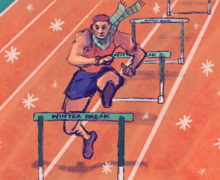For potential Carrier Dome renovations, experts suggest better WiFi, avocado toast
Jessica Sheldon | Senior Staff Photographer
The Carrier Dome opened in Syracuse in September of 1980.
With a decision to come by late spring on the Carrier Dome roof, per Syracuse Director of Athletics John Wildhack, The Daily Orange asked several sports-business experts how the university could spruce up the venue. Their insight is based on industry best practices, trends across the college athletics landscape and research of their own. Most experts agreed an air conditioning system would be costly and probably not worth the investment. Experts also said the same in regards to a retractable roof.
Nonetheless, the Dome, built in 1980, is a key piece of the Syracuse skyline and one of the most recognizable structures in central New York. Here are some of their ideas on how SU could make the facility a better place.

Daily Orange File Photo
The roof and exterior
A new or recently renovated roof will not drive fans to the game, said Nels Popp, an assistant professor of sport administration at North Carolina. But a well-designed roof contributes to the overall fan experience in that it contains the sound better, which would only add to the Dome’s nickname, “The Loud House.”
Beyond the roof, five experts agreed that a relatively cheap addition with a high payout would be exterior signage. A large “S” plastered on the stadium’s wall could be read from Interstate 81. Another orange “S” on the ground could function as a destination for visitors and a meeting spot for fans before games. Such signage gives fans a “sense of place and arrival,” said Rafi Kohan, author of “The Arena,” a book about sports stadiums.
They can also be a revenue source. Popp said Chicago’s United Center learned to profit from the Michael Jordan statue outside the venue. Staffers noticed that busloads of visitors stopped solely to see Jordan’s statue, so they decided to monetize it. There is a coffee shop and merchandise shop nearby, from which they drive revenue.
For Syracuse, Johnson said statues of famous figures in the university could be effective, including people such as head men’s basketball coach Jim Boeheim. Not to mention, a Hall of Fame or similar exterior experience outside of sports venues can be effective.
“The walk-up becomes part of the experience,” said Brian David Johnson, a professor of practice at Arizona State’s School for the Future of Innovation in Society. “Outside the venue, food trucks and mobile bars on game days become an experience in itself. The Quad could be an area to explore for more entertainment options.”
The interior
The trend nationwide hinges on open-air, open-concourse and natural-light-filled facilities. They have extensive food options, gift shops, bars and, sometimes, swimming pools (EverBank Field) and barbershops (Barclays Center). Several experts suggested that removing the cinder-block walls between the playing surface and the main concourse could open up the arena while allowing fans to watch the game as they stand in line for food.
“It’s a bit like jail in these old stadiums,” Johnson said. “You can’t leave the seats. You can’t watch the game. It’s closing everybody off. We need a free-flowing experience.”
But Kohan said opening up the concourse could be expensive and difficult to complete. Older facilities such as the former Yankee Stadium, or the Dome, could embrace the contrast of walking from a dark concourse to bright seating area and playing surface. Kohan also recommended segmenting arenas, or creating miniature “neighborhoods.” Dividing concourse areas to appeal to children, working professionals and loyal, older fans fulfills the needs of most fans, he said.
Experts didn’t agree on whether improved seating would lead to more ticket sales. Stadiums are reducing the number of seats to add more luxury boxes and sections, said Robert Malekoff, a lecturer at North Carolina’s School of Exercise and Sport Science. Luxury boxes are a key revenue driver for many athletic departments and front offices. In 2005, Courtside seats were introduced for SU men’s basketball games to combat drying up Big East revenue. They now offer the university about $2 million per year in revenue.
“It’s not uncommon to reduce the number of actual seats in the venue and add more luxury seating,” Malekoff said. “The Dome would be a little unique in that it’s the only show in town. But luxury box seats? I would be absolutely stunned if that wasn’t part of the priority of a renovation there.”

Jessica Sheldon | Senior Staff Photographer
WiFi
If given five minutes to consult with an athletic department, Temple assistant professor of sport management Thilo Kunkel would keep his message simple: upgrade the WiFi.
The wireless network OrangeHotspot was installed in 2013 inside the Dome. In the summer of 2016, SU upgraded WiFi speeds, as well as video boards and scoreboards. Fans may be accustomed to fast WiFi speeds at venues such as Yankee Stadium and New Era Field, Johnson said, and faster speeds allow them to post on social media while interacting with one another.
“WiFi is a deal breaker,” Kohan said. “If you don’t have fast WiFi, you’ll hear about that.”
Food
A walk around Walt Disney World’s Epcot Theme Park takes a visitor around the world, where various food options are offered. It’s an element that has translated to sports venues, said experts including Popp. The idea is to provide as many options as possible to satisfy fans, including the growing gluten-free and vegan crowds.
To appeal to casual fans, Kunkel advises more craft beer, regional food and healthy options. He said rather than sell traditional hot dogs, sell a New York hot dog. And rather than selling generic beer, sell craft beers brewed in central New York.
“That’s how you can get fans who are not there for the football but because they are tagging along,” Kunkel said. “That’s how you get them to commit and go again. It may not be because of that touchdown, but because of that smashed avocado toast.”
As football games lengthen, Johnson said fans are growing accustomed to viewing the game from their seats. Small, themed restaurants and cafes along the perimeter of venues can attract guests to view the game from areas other than their seat. Improvements to Carrier Dome concessions, experts said, is a relatively small-scale investment that can make fans want to come back for the food alone.
Published on April 16, 2018 at 11:37 pm
Contact Matthew: mguti100@syr.edu | @MatthewGut21






